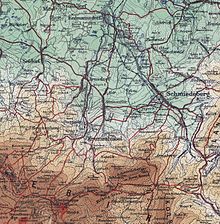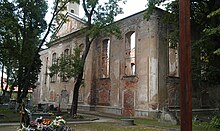Miłków (Podgórzyn)
| Miłków | ||
|---|---|---|

|
|
|
| Basic data | ||
| State : | Poland | |
| Voivodeship : | Lower Silesia | |
| Powiat : | Jelenia Gora | |
| Gmina : | Podgórzyn | |
| Geographic location : | 50 ° 49 ' N , 15 ° 46' E | |
| Height : | 415-655 m npm | |
| Residents : | 2200 | |
| Postal code : | 58-535 | |
| Telephone code : | (+48) 75 | |
| Economy and Transport | ||
| Next international airport : | Wroclaw | |
Miłków ( German Arnsdorf ) is a district of the rural community Podgórzyn ( Giersdorf ) in the Powiat Jeleniogórski ( Hirschberg district in the Giant Mountains ) in the Polish Voivodeship of Lower Silesia .
Geographical location
The village is located in Lower Silesia in the Giant Mountains , about eleven kilometers south of the district town of Jelenia Góra ( Hirschberg in the Giant Mountains ) and 97 kilometers west of Wroclaw .
history

The place name has changed several times in the course of history:
- 1305 Arnoldi Villa
- 1394 Arnoldisdorf
- 1400 Arnsdorff
- 1668 Arnssdorffischen
- 1765 Arnsdorf
- 1786 Arnoldsdorf, Arnsdorf,
- 1945 Hlondów, Jurantów, Jarantów,
- 1946 Miłków
The place was probably founded at the end of the 13th century by settlers from Thuringia and Middle Franconia . The place name Arnoldi Villa ( village of Arnoldi ) can be traced back to the then Vogt Arnold. Arnsdorf is documented as early as the middle of the 13th century. The people lived from agriculture and animal husbandry.
In 1436 Lorenz von Runge acquired the rule of the villages of Arnsdorf, Steinseiffen and Querseiffen from Johann von Niebelschütz. In 1491 the von Runge family sold the rule to the von Reibnitz brothers . In 1656 Baron Karl Heinrich von Zierotin bought the rule and built the castle in 1667.
For the adoption of the Lutheran doctrine around 1552, the rule in the Thirty Years' War suffered a lot. Multiple Arnsdorf was plundered and pillaged , including in the Silesian Wars .
Arnsdorf later became a center for herbalists and laboratory technicians, who made tea, stomach drops and other household remedies from the herbs growing in the mountains and traded with them, which made them quite prosperous. By a new trade regulation for laboratory technicians at the time of Friedrich Wilhelm III. if they lost this authorization, it was left ad dies vitae to those who lived at the time .
In the 18th century tourism developed in the Giant Mountains and became an important economic factor in Arnsdorf. Many residents worked as mountain guides or as litter carriers. At the beginning of the 19th century, this led to the introduction of mountain guide cards in neighboring Krummhübel and Arnsdorf in 1822 and the remuneration of mountain guides and litter carriers to be determined by district ordinances. Tourism experienced a further boom after Arnsdorf was connected to the railway network with the Giant Mountains Railway in 1895 . At the beginning of the 20th century, Arnsdorf had a Protestant church, a Catholic church, several factories and a yarn bleaching shop.
In the book "Sommerfrische Arnsdorf" from 1912, the scenic charms of Arnsdorf are described in great detail: “ The place owes its growing importance not to artificial advertising, but only to its natural advantages, above all to its friendly location at the end of the romantic Lomnitz valleys. While the lower part of the village is exposed, the upper part, the so-called 'Dittrich', is hidden between wooded heights. Forests crowd in from three sides, and a network of good paths hugs the place. The Kaiser-Friedrich-Monument offers an impressive view of the high mountains. “( Editor: Local and Tourist Association : The book" Sommerfrische Arnsdorf ")
In 1945 Arnsdorf belonged to the district of Hirschberg in the Giant Mountains in the administrative district of Liegnitz in the Prussian province of Silesia of the German Empire .
After the Second World War , Arnsdorf, like almost all of Silesia, was placed under Polish administration by the Soviet occupying power . The Poles first introduced the place name Hlondów for Arnsdorf , which was then changed to Miłków in April 1946 . In the period that followed, the local German population was almost completely expelled from Arnsdorf by the local Polish administrative authority .
- Population development
| year | Residents | Remarks |
|---|---|---|
| 1900 | 1.916 | |
| 1933 | 1,866 | |
| 1939 | 1,896 |
Buildings
Catholic Church of St. Hedwig
The church was probably built in 1289, because this number is in the church wall. Epitaph stones from the 18th century stand on the outer wall . They are reminiscent of the herb collectors who lived here at that time. In the wall of the cemetery that surrounds the church, three atonement crosses from the 14th to 16th centuries are immured.
Evangelical church ruins
About 200 meters away are the ruins of the Protestant baroque church from the 18th century. It was destroyed in 1945. Only the tower, which was added after 1860, and the outer walls of the church are still standing, but the inside of the gutted nave is densely covered with bushes and trees. The typical architectural form of the Protestant churches in Lower Silesia at the end of the 18th century can be recognized.
The church's cemetery, which extends south and east of the ruin, is now used by the Catholic community. On the east side of the ruin there are and still are granite tombstones with German inscriptions: Christiane Langner, Agnes Krahn, saddler Alfred Heisig, painter and etcher Hans Seydel, foreman Oswald Krebs and others.
One of the three bells from 1863, which ended up in the Hamburg bell cemetery during the war , hangs today in the new tower of the Vicelinkirche in Hamburg-Sasel .
lock
In the center of the village stands the baroque castle in a well-tended park. It was built in 1667 by Karl Heinrich von Zierotin . Later it belonged to Count Matuschka , then until 1945 to Count Schmettau . Today there is a hotel in it.
railway station
200 meters from the evangelical church ruins is the disused small station of the Giant Mountains Railway .
Ruin on the Galgenberg
Former place of execution of the place or the lordship
Sons and daughters of the place
- Felix Eberty (1812–1884), lawyer, amateur astronomer and writer
- Margarete Hielscher (1899–1985), doctor, involved in Nazi crimes as part of “child euthanasia”
- Gotthard Günther (1900–1984) philosopher and logician
- Ryszard Lenczewski (* 1948), cameraman
- Michael Oppitz (* 1942), ethnologist
- Reinhard Spree (* 1941), historian
Web links
- Description of the place on the municipality's website (Polish)
- History of Arnsdorf
- Sommerfrische Arnsdorf in the Riesengebirge , from: Description of places in the Silesian region, published by the local and tourist office in 1912
- Travel tips Arnsdorf (Miłków) , from: Cities and regions in Lower Silesia
- Memories of Johannes Dittrich from his childhood in Arnsdorf in the middle of the 19th century








